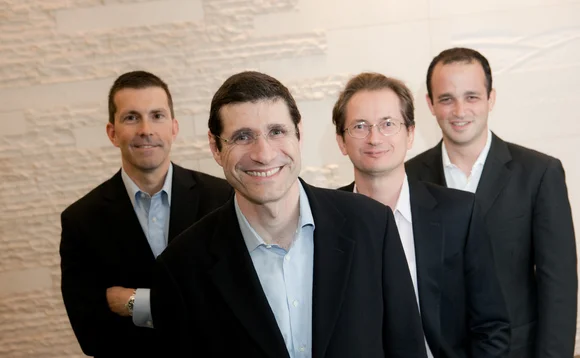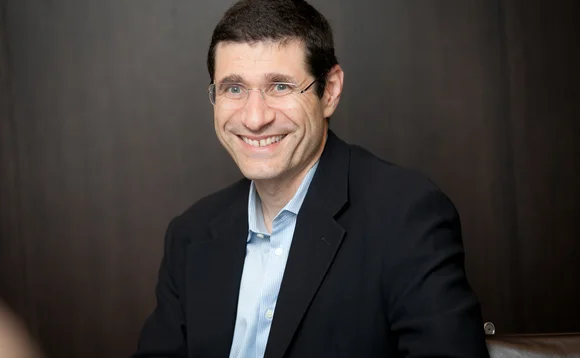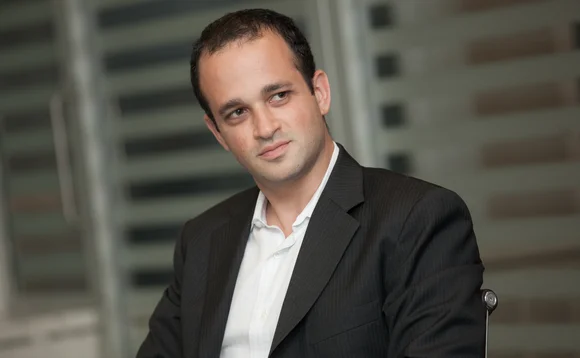Mountain Lions: Pursuit of IT Innovation Keeps BlueMountain Ahead of the Pack





Michael Liberman, a senior executive at one of the most respected hedge funds in the US, stands in the lobby of BlueMountain Capital Management’s Manhattan headquarters. He’s doing his best to keep a straight face as he’s flanked by three of his closest colleagues.
Out of the silence and seriousness comes an automated, Stephen Hawking-esque voice modulator that delivers an indecipherable statement. Liberman, along with Jeff Szilagyi and Perry Vais, crack up and their V-formation pose falls apart. Axel Kramer is off to the side, flashing a guilty smile. These shenanigans continue for the next hour, and, surprisingly, doesn’t become tedious. This familiarity has been solidified by nearly a decade of daily interactions. In early 2004, shortly after co-founders Andrew Feldstein and Stephen Siderow launched the $5.6 billion hedge fund the previous November, Liberman joined as its chief operating and risk officer. He was soon thereafter reunited with former JPMorgan colleagues Kramer and Szilagyi. Vais completed the quartet in 2006.
The world of financial technology is often a revolving door of activity that sees continuous turnover and transition as the same group of players bounce around between the vendors and end-users in search of new opportunities, higher pay, or a move off the unemployment line. But at BlueMountain, this group has established what in the financial technology world can best be described as a dynasty. Since 2008, this industry has seen much turmoil, but when it comes to IT, Liberman and his team have found stability.
“Our vision was to build a world-class investing and risk management infrastructure,” Liberman says. “Since we were able to build it from scratch, we focused on building a technology platform to fit our business, and not the other way around.”
This was the structure from the very beginning and it has created a familial environment across the firm, according to Szilagyi, co-head of quantitative strategy. “That collaborative aspect is not just in our group—it’s across the entire organization,” he says. “You have some freedom to try and solve problems that come up. Some of those solutions might involve technology, some may not, but if it’s for the commercial good of our business then we can go and do that and see the immediate impact. I wake up in the morning and know that I can go to work and do something that will impact everybody.”
“Experiments are encouraged here. They might fail, but in order to move forward we play around with things like Mongo or Cassandra. We don’t know yet if those will be the ultimate solutions for our fund, but we’ll give it a shot and figure out how far we can go or what we can do to enhance the database to integrate them with our systems. It’s very important to our business to have that ability to experiment.” —Axel Kramer
It is this level of trust that has led to BlueMountain earning a reputation as one of the most innovative firms on the Street, adds Kramer, BlueMountain’s co-head of quantitative strategy.
“We’ve known each other for more than eight years,” he says. “There’s a certain level of trust that develops and we are all pretty hands-on and we all chip in. There is low overhead and low bureaucracy in what we do every day, and that’s what I love about being here.”
Since this core has all but been at BlueMountain since its inception, they’ve been able to carve out their own style, and, as a result, are not afraid to admit that not every project or test is going to succeed—in fact, most won’t. BlueMountain engages in a fair amount of experimentation where the final answer is unknown at the outset.
But they trust one another and upper management has since instilled its trust in them. Still, Liberman says trust can be lost and no one should rest on their laurels.
“We’ve built a lot of credibility by delivering results, and we have used that credibility to innovate. But we always understand that we have to renew it—there’s no way for us to say that we’ve been here for eight years and that’s all we need,” he says.
Thinking Differently
On Kramer’s LinkedIn profile, where most people list their current position and company, he has chosen to be philosophical, writing instead: “{Learn–design–implement–observe} repeat.”
Vais, co-head of quantitative strategy, puts it slightly differently: “We know the questions that we want to have answered—we just don’t know how we’re going to answer them yet,” he says. “We’ll try lots of different approaches to get to that answer and ultimately you get to an approach that feels natural and really expresses the question that you’re trying to answer. It takes a couple of iterations.”
This process can best be illustrated by the fund’s new research management system, which it is currently building. The platform is designed to allow the firm to more easily analyze opportunities across various asset classes, while integrating its risk and financial models. It can compute raw statistics, visualize the data, and is backed up by terabytes of market data. BlueMountain has had to build out its networks as a result, as well as dig fiber to its three datacenters. It has also had to upgrade its networking backbone and it now runs hundreds of new servers, according to Vais.
To enhance this platform, BlueMountain is in the preliminary stages of experimenting with new programming languages. In the first mock-up for its research platform, the group turned to Python Programming Language. While Vais says Python is a fine offering, it didn’t work well in BlueMountain’s environment and it wasn’t answering questions the way the team wanted it to.
So BlueMountain scrapped that project and is now looking at Microsoft’s F# language, which Vais says is quite different from how the firm has traditionally gone about answering questions. But he calls it a “fantastic” tool for quickly creating mock queries for looking at data or running models, although he adds that he is still not sure whether F# will be the final answer—but that’s what makes going to work every day exciting.
Vais says nothing at BlueMountain is ever really final and fully implemented—rather, everything is iterative and evolving.
The research overhaul has led to the firm hiring new staff, although this has been a slow process because the chemistry part of the equation is more vital to get right than simply growing the headcount. The Quantitative Strategies unit, which combines quants and IT, is a relatively small group of about 20, and each new addition is significant.
Vais says this new research system represents about four or five major projects. BlueMountain has had to go through a massive market data undertaking as a result. Additionally, the visualization piece of the upgrade has proven challenging, as they try to get an understanding of what the data they’re looking at means, which language to use to express these ideas, and how to improve the graphics tools to better understand the information provided.
“We don’t know all the answers yet, but our culture of experimentation makes me confident that we’ll find them,” Vais concludes.
Experiments Encouraged
Underpinning everything new that BlueMountain is building is its Financial Object Model (FinOM) platform, which is currently in Version 5, according to Liberman. “We created the FinOM, a flexible and powerful foundation for creating financial applications and tools,” he says. “It has the finance layer, which has the quantitative library, financial instruments, financial scenarios, trade models and all the reference data. Then there’s the core infrastructure for dependency graph or distributive computing and the user interfaces. Based on that framework, we built all the tools for our businesses.”
Liberman adds that he’s impressed with the scale that they’ve been able to achieve as a result of this backbone.
“We collect vast amounts of market data, we have thousands of compute processors, and we produce hundreds of millions of calculations each day. We have a system that runs our automated processes—I think it’s something like 23,000 every day—and we manage over 100 terabytes of replicated data,” he says.
As a result of its stabilized infrastructure, the group can tinker with new, bleeding-edge technologies, Kramer says. BlueMountain has been looking at open-source database solutions such as MongoDB and Apache Cassandra, which is already being employed to support its new market data system.
“Experiments are encouraged here,” Kramer continues. “They might fail, but in order to move forward we play around with things like Mongo or Cassandra. We don’t know yet if those will be the ultimate solutions for our fund, but we’ll give it a shot and figure out how far we can go or what we can do to enhance the database to integrate them with our systems. It’s very important to our business to have that ability to experiment.”
Not only can the firm experiment, but it can also adjust to new opportunities and challenges that are created on the business side. In March, BlueMountain acquired Crédit Agricole’s structured credit business, the legacy portfolio of derivatives contracts that was shuttered three years ago. To unwind these contracts, BlueMountain developed the Alpine fund that would create new contracts that mirror the old ones, and which can then be integrated into BlueMountain.
This deal was made possible by regulatory pressures that led firms like Crédit Agricole to offload their investment banking operations. Liberman points to these regulation-created opportunities as a prime example of how BlueMountain’s infrastructure has allowed it to capitalize on new openings in the market, as the firm was able to absorb the portfolio without any additional resources on the technology or operations sides of the business.
“It was a good demonstration of how our infrastructure can deal with a very large portfolio of trades that needed to be integrated into our profit-and-loss risk processes,” says Kramer, adding that the portfolio has been fully integrated. “There were new contractual requirements, analytics and algorithms to be used. We are still working on putting it into our day-to-day production, but I think that it showed off the infrastructure that we have beautifully.”
BlueMountain also made headlines for being on the upside of the bloated bets made by JPMorgan’s Bruno Iksil—infamously dubbed “The London Whale”—whose trades cost the bank billions of dollars in losses. In a twist, Bloomberg reported that BlueMountain was helping JPMorgan unwind these trades, thus making additional profits for the fund. BlueMountain declined to comment on these reports.
The Importance of Trust
A kind of circular logic drives BlueMountain’s overall business ethic in addition to its technology stance: Trust leads to collaboration, collaboration leads to innovation, innovation leads to results, and results lead to renewed trust. Nothing is ever finalized, but at the same time, nothing is ever dismissed. “I’m always worried about missed opportunities, but the nice thing about working here is that we always have the opportunity to readdress things and change the way we view things and evolve,” says Szilagyi.
These are indeed challenging times for most every financial institution. And, as JPMorgan found out with the Iksil fiasco, even the more celebrated institutions can find themselves among the losers. This can create moments of high anxiety, although stability and trust have proven to be reliable assets at BlueMountain.
“Our infrastructure enables our investing and distinguishes us with our investors—they love our infrastructure and want to invest with us because of how good we are. But a single mistake can have serious consequences as we see with headlines of funds blowing up over risk management or operational mistakes,” Liberman says. “That makes me nervous all the time.”
Only users who have a paid subscription or are part of a corporate subscription are able to print or copy content.
To access these options, along with all other subscription benefits, please contact info@waterstechnology.com or view our subscription options here: https://subscriptions.waterstechnology.com/subscribe
You are currently unable to print this content. Please contact info@waterstechnology.com to find out more.
You are currently unable to copy this content. Please contact info@waterstechnology.com to find out more.
Copyright Infopro Digital Limited. All rights reserved.
As outlined in our terms and conditions, https://www.infopro-digital.com/terms-and-conditions/subscriptions/ (point 2.4), printing is limited to a single copy.
If you would like to purchase additional rights please email info@waterstechnology.com
Copyright Infopro Digital Limited. All rights reserved.
You may share this content using our article tools. As outlined in our terms and conditions, https://www.infopro-digital.com/terms-and-conditions/subscriptions/ (clause 2.4), an Authorised User may only make one copy of the materials for their own personal use. You must also comply with the restrictions in clause 2.5.
If you would like to purchase additional rights please email info@waterstechnology.com
More on Emerging Technologies
As trading firms embrace AI, so do hackers
According to a Google cybersecurity report, cybercriminals are turning to AI to sharpen their attacks.
AI & data enablement: A looming reality or pipe dream?
Waters Wrap: The promise of AI and agents is massive, and real-world success stories are trickling out. But Anthony notes that firms still need to be hyper-focused on getting the data foundation correct before adding layers.
Waters Wavelength Ep. 343: Broadridge’s Jason Birmingham
This week, Jason Birmingham of Broadridge talks with Tony about the importance of fundamentals as technology rapidly evolves.
Data standardization is the ‘trust accelerator’ for broader AI adoption
In this guest column, data product managers at Fitch Solutions explain AI’s impact on credit and investment risk management.
BNY inks AI deal with Google, Broadridge moves proxy voting to AWS, Expero delivers ICE market data, and more
The Waters Cooler: TSX Venture Exchange data hits the blockchain, SmartTrade acquires Kace, and garage doors link to cloud costs in this week’s news roundup.
Everyone wants to tokenize the assets. What about the data?
The IMD Wrap: With exchanges moving market data on-chain, Wei-Shen believes there’s a need to standardize licensing agreements.
Google, CME say they’ve proved cloud can support HFT—now what?
After demonstrating in September that ultra-low-latency trading can be facilitated in the cloud, the exchange and tech giant are hoping to see barriers to entry come down.
Waters Wavelength Ep. 342: LexisNexis Risk Solutions’ Sophie Lagouanelle
This week, Sophie Lagouanelle, chief product officer for financial crime compliance at LNRS, joins the podcast to discuss trends in the space moving into 2026.







